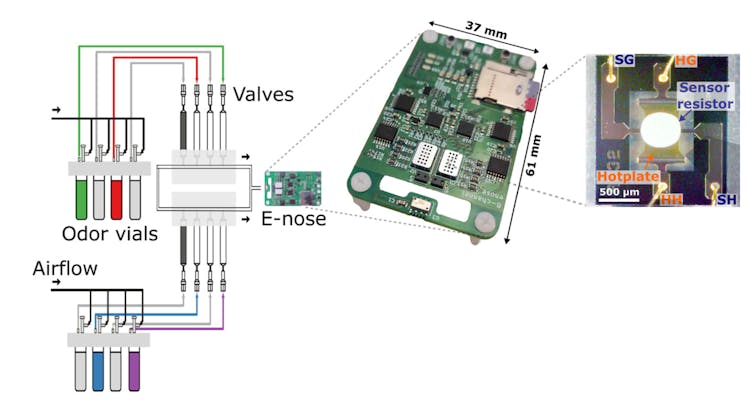
Imagine a robot that can detect scents in the air and track down their sources as efficiently as a dog or a mouse. If realised, it could detect small wildfires in dense forests, find people buried in debris after an earthquake, or even hunt for truffles!
Our research team has brought this vision one step closer to reality, by creating a compact electronic nose capable of identifying odours within milliseconds.
In our study, the goal was to explore this artificial sense of smell, and test how fast we can extract valuable information about the environment from the air. We show that the “speed of smell” matches and sometimes even exceeds those of mammals.
Our study is now published in Science Advances.
Complex and informative odour landscapes
Animals perceive smells incredibly quickly, and this ability has evolved over millions of years to optimise their chances of survival. But why is such speed necessary?
The answer lies in the complex nature of how odours move through the air. Unlike what you might think, odours don’t just grow steadily weaker as you move away from their source to where they are detected.
Instead, air movements create a highly chaotic environment where odours travel in irregular plumes that can be extremely brief and spaced out over time. These plumes are shaped by a mix of small- and large-scale turbulent air dynamics, including wind shearing and molecular diffusion, as well as by environmental boundary conditions.
Understanding these odour plumes is crucial for animals. Each brief encounter with an odour can carry valuable information.
For instance, by analysing the timing and frequency of these odour bursts, an animal can estimate how far it is from the source. If the animal notices that two different odours always occur together, it could mean their sources are in close proximity to each other. Variations in the concentration of these bursts can also hint at the size and spread of the odour plume.
These subtle clues help animals make quicker decisions about where to find food, avoid predators, or locate mates. But to unlock this information, their sensory and nervous systems must be fast enough to pick up and process these rapid changes in the odour landscape.
The speed of smell in animals and machines
The speed at which animals can detect and react to smells varies by species. Insects like grasshoppers and fruit flies process scent signals in just a few milliseconds, helping them move in and react to their environments with ease. Mosquitoes can detect tiny bursts of carbon dioxide as short as 30 milliseconds, which is why they find you so easily at night.
Mammals were once thought to have slower smell detection, but recent studies have shown otherwise. A landmark study in 2021 revealed mice could tell apart odours from mixed and separate sources in mere milliseconds. A paper published last month found that even humans can distinguish between different scents delivered just 60 milliseconds apart.
While fast odour sensors exist — devices such as photo-ionisation detectors — they are too bulky, power-hungry and often not selective enough to be used in robots. The device we developed now bridges this gap.
We found it could accurately identify odours in bursts as short as 50 milliseconds. Even more, it could decode patterns between odours switching up to 40 times per second, which is similar to what mice can do when they perform source-separation tasks. This means our device can “smell” at speeds that match those of animals.
How did we do it?
Our electronic nose is built on a multi-layer circuit board a little smaller than a credit card. It’s equipped with multiple metal-oxide gas sensors as well as temperature and humidity sensors.
What sets our device apart from others is the use of high-end electronics that can sample and control these sensors extremely fast and precisely, as well as custom-designed algorithms and processing methods.

The sensors work by changing their electrical properties based on how different gases react with an oxide layer on the surface. A crucial part of making the sensors so responsive is heating the tiny sensing sites to several hundred degrees.
In turbulent air, sensor temperature tends to fluctuate, which makes odour detection and identification more difficult. By constantly measuring and re-adjusting the temperature with a high level of precision, we achieved a highly sensitive sensor response that could detect even slight, fast changes in odours.
We also discovered that rapidly switching the temperature back and forth between 150°C and 400°C about 20 times per second produced quick, distinctive data patterns that made it easier to identify specific smells. This approach allowed our device to pick up odours with remarkable speed and accuracy.
Applications and impact
Equipping robots with fast odour sensors will allow them to detect and react to environmental cues in real time. This will enable more efficient navigation and decision making in challenging scenarios, opening doors for many promising applications.
For example, the early detection of wildfires could save gigatonnes of carbon dioxide emissions. Conventional detection methods like satellites and planes only spot fires once they reach a significant size. Fires burning below the forest canopy or behind clouds can be missed entirely.
Drones equipped with fast electronic noses could change that by patrolling the forests, identifying small plumes of smoke, then navigating towards and localising the source. With this, large areas could be covered efficiently and fires detected before they grow out of control.
Another critical application may be found in disaster response. After earthquakes or building collapses, finding survivors quickly is crucial.
Olfactory robots equipped with fast electronic noses could play a life-saving role by detecting the unique scent signatures of humans trapped under debris. By rapidly scanning through complex environments and identifying human scent traces, these robots could guide rescue teams to victims faster than traditional methods, increasing the chances of survival.
And for the truffles? Perhaps one day, our robot could give truffle-hunting pigs a run for their money, proving that even technology has a nose for fine dining.
Nik Dennler does not work for, consult, own shares in or receive funding from any company or organisation that would benefit from this article, and has disclosed no relevant affiliations beyond their academic appointment.
This article was originally published on The Conversation. Read the original article.







